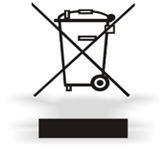Important safety instructions
CE conformity information
The 3D Printizer is a DIY 3D printer kit, it contains all the bits and pieces to construct your own 3D printer but does not contain additional protection. As it is a kit and not a finished product, compliance with the CE regulations depends on the build-quality; also the following notes must be taken into account.
Electrical safety
The included power supply meets all the applicable European requirements and bears the CE-mark. It is protected against overload and short circuit and nothing needs to be modified. The working voltage of the 3D printer is 12-24Vdc (extra low voltage) and therefore it's outside the scope of the Low voltage directive. ! Always unplug before maintenance or modification.
Electromagnetic radiation (EMC)
Conductive EMC towards the public distribution network is not an issue as this is related to the power supply. Radiated EMC depends substantially on the build quality, it might be required to add shielding but this cannot be predicted. A built 3D Printizer should comply with EN50081 normation
Mechanical safety and protection
The 3D printer contains a lot of moving parts, but the force of the stepper motors is too low to cause serious injuries. Nevertheless it is recommended to provide additional protection against mechanical risks. The easiest way to make your 3D printer "accident proof" is to put it inside a protective enclosure which completely covers the 3D printer - with or without an access door and fume extraction. (numerous designs can be found on the internet) To make it extra safe a switch which interrupts the power supply of the printer when the enclosure or door is opened can be added. It is also advisable to install an external emergency stop switch, which also cuts off the power supply. Providing adequate protection is the responsibility of the assembler. ! Always cut power before maintenance or modification.
Risk of burns
There is a potential risk of burns as the Printer head (extruder) can reach up to 250 degrees Celsius. The use of common sense should be sufficient to prevent burns, but in some environments it is highly recommended to provide additional protection. (see Mechanical safety and protection section) The max. temperature of the heated bed is 120 degrees Celsius, this is below the 1 min. burn threshold for plastic surfaces according to CENELEC Guide 29. Normal reflexes prevent long contact periods with hot surfaces ! Always lt the 3D printer cool down for 60 min. before maintenance or modification.
Health
This printer is designed for use with PLA and ABS filament.
PLA: is a safe and non-toxic material, there are no known health safety risks when used in 3D printers.
ABS: when printing with ABS there is a distinctive "burned plastic" smell. This is quite normal but it may also cause headaches, respiratory- and eye irritation with sensitive people (although it is not toxic) ! Only use the printer in a well-ventilated area, if printing with ABS it is advisable to add a fume hood (with active carbon filtering for ductless extraction). Fume extraction is mandatory for use in offices, classrooms and alike. Never burn printer filament, toxic gasses and vapors will be generated if exposed to fire.
General safety information
The 3D printer is not intended for use by persons (including children) with reduced physical, or mental capabilities, or lack of experience and knowledge, unless they have been given supervision or instruction concerning the use of the appliance by a person responsible for their safety Children should be supervised to ensure that they do not play with the appliance. The above information is believed to be correct but does not purport to be all inclusive and shall be used only as a guide.
The information in this document was obtained from sources which we believe are reliable.
However, the information is provided without any warranty, express or implied, regarding its correctness.
The conditions or methods used for assembling, handing, storage, use or disposal of the device are beyond our control and may be beyond our knowledge. For this and other reasons, we do not assume responsibility and expressly disclaim liability for loss, injuries, damage, or expense arising out of or in any way connected with the assembly, handling, storage, use or disposal of the product.
Waste Electrical and Electronic Equipment (WEEE) Disposal Instructions

Contact your municipality or the nearest collection site to dispose of Electrical and Electronic Equipment waste.